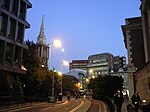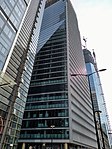Baltic Exchange
1744 establishments in Great BritainCommodity markets in the United KingdomEconomy of LondonEngvarB from June 2017Futures exchanges ... and 3 more
Service companies of the United KingdomShip charteringShip management

The Baltic Exchange (incorporated as The Baltic Exchange Limited) is a membership organisation for the maritime industry, and freight market information provider for the trading and settlement of physical and derivative contracts. It was located at 24–28 St Mary Axe, London, until the building was destroyed by a bomb in 1992. The Baltic Exchange moved into a new building at 38 St Mary Axe on 15 May 1995. It is now located at 107 Leadenhall St and has further offices in Europe, across Asia, and in the United States.
Excerpt from the Wikipedia article Baltic Exchange (License: CC BY-SA 3.0, Authors, Images).Baltic Exchange
Saint Mary Axe, City of London
Geographical coordinates (GPS) Address Nearby Places Show on map
Geographical coordinates (GPS)
| Latitude | Longitude |
|---|---|
| N 51.5151 ° | E -0.0802 ° |
Address
The Baltic Exchange
Saint Mary Axe 36
EC3A 8BY City of London
England, United Kingdom
Open on Google Maps





